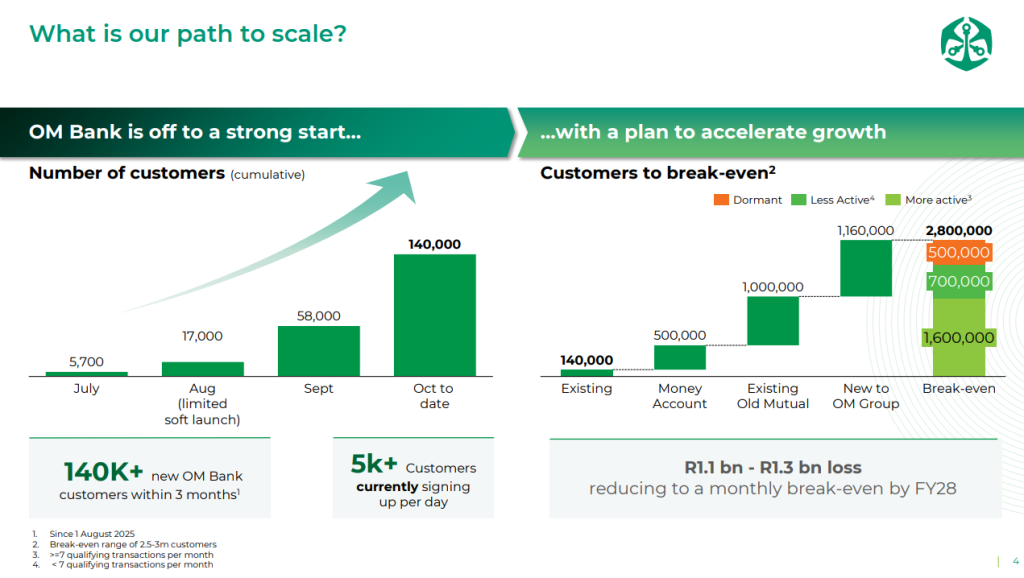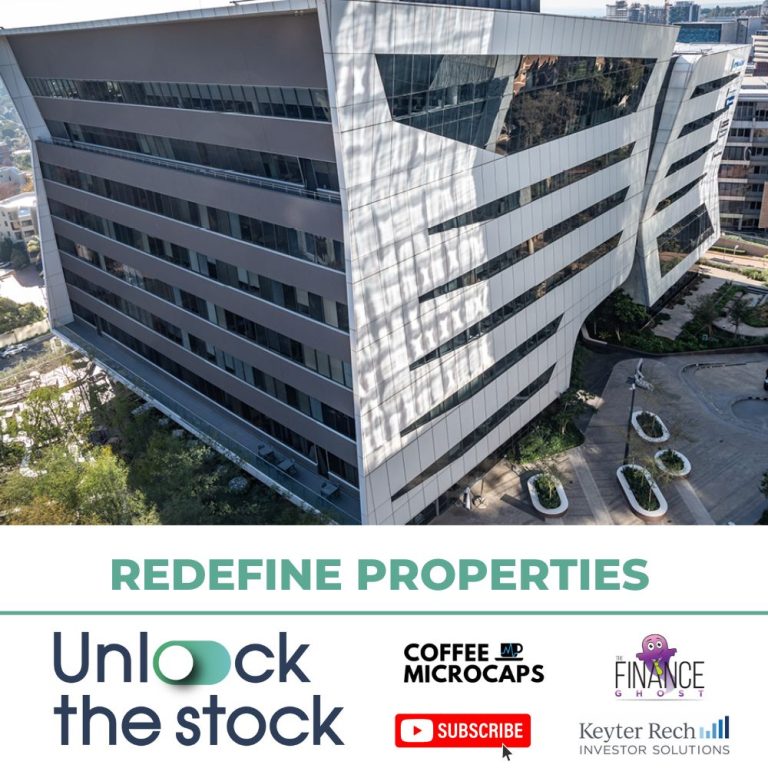Optasia is listing on the JSE, which means that South African investors will have the opportunity to invest in this exciting fintech business. With a proprietary platform and extensive relationships across numerous emerging and frontier markets, Optasia builds bridges between financial institutions and underbanked consumers seeking airtime credit and microfinance solutions.
To explain how the business works, Salvador Anglada (CEO, Optasia) joined me for this detailed discussion. We covered the core underlying model, the DNA of the business and the journey to scale, along with the importance of the relationships that have been built in this ecosystem. We also covered off the risks and opportunities for the group.
As always, remember to do your own research and to treat this podcast as being for informational purposes only. For more information on Optasia, visit the website here.
Listen to the podcast here:
Transcript:
The Finance Ghost: Welcome to this episode of the Ghost Stories podcast. I come to you at a very exciting time because we are talking about a new listing on the JSE – drumroll please! How great is that? We are so used to hearing about delistings – it is lovely to be talking about a genuine IPO, a business coming to the JSE, raising money, giving South Africans a chance to participate – and also just what a cool growth story. I’ve really enjoyed actually engaging with the pre-listing docs that have gone out, everything that has been put out there.
I’m personally really looking forward to this conversation. We are having it with exactly the right person, that is Salvador Anglada. He is the CEO of Optasia, a really exciting business that is coming to the JSE. Salvador, thank you so much for squeezing this into your busy diary of roadshows and speaking to institutional investors. I know that Optasia values the retail investor audience. That’s where this is ultimately going. Thank you so much for that, for your time. I’m just looking forward to getting to know more about the business.
Salvador Anglada: Good afternoon, everybody. Good afternoon, Ghost, and thank you for having me here today. It’s a big pleasure to share with you this time this afternoon.
The Finance Ghost: It’s going to be great. I’m excited. Let’s jump straight into it. When I look on the Optasia website I see words like financial empowerment, inclusivity, unlocking access, really powerful stuff. These are the words that feature prominently in the way that Optasia describes the business. It sounds like the right strategy when you think about emerging markets and frontier markets, particularly when you’re trying to scale and reach a size where the economics look really good. I think let’s begin with the simplest question of all because the market is not familiar at this stage with the Optasia business: what does the company actually do? Can you describe for us as simply as possible what the business model is?
Salvador Anglada: What we do really is to solve a problem that exists in a lot of countries, what we call underbanked countries. There are a lot of people that they don’t have access to financial services, so what we do is to solve that problem using technology, we are able to provide credit, loans and financial services to all these people. And we are doing that, creating an alternative way of scoring the risk of the people without structured data, without credit bureaus, without anything that the developed world uses.
We use our technology, we collect data, we create a credit scoring for every single person. We’re able to decide on the amount and the affordability of any person using data, as I said, and connecting with their mobile wallets or any single device that the person has in order to receive the money. This is what we do. We do it at scale – operating in more than 38 countries, we have been able to scale to 120 million* active customers that receive our loans per month. A machine that is being created, when I say a machine – an engine more than a machine, connecting the dots and allowing us today to take more than 30 million credit decisions as we speak every single day. Also to disburse more than $13 million of credit also every single day. This is what it is, a platform that allows us to provide credit at scale big business.
The Finance Ghost: It’s an impressive story. And I think you’ve raised such an interesting point there, which is that without the data, what tends to happen is people assume that the risk of providing financial services to unbanked people is much higher than it actually is. So that’s what the technology is doing, right? It’s closing that gap. It’s saying to financial services providers, actually we know something about these people, we’ve built out these models, we understand this market a lot better. That allows you to price for the risk and it allows people to get access to financial services that they might not be able to get any other way. That’s what I’m understanding from you.
Salvador Anglada: Yeah, I would say this is exactly what it is. We are building up a model that allowed us to include all these people in the possibility to have access to financial services. And the only way using technology, as you said, I mean the way that a traditional bank provide credit is first of all, you need to have a bank account. Second, they ask you for your salary certificate and then normally they calculate a percentage of that and they give it that as a credit. We are talking with people that don’t have bank account, a lot of them don’t have a salary certificate. The beauty is to collect all this structured and unstructured data, hundreds of thousands of different data. We take more than 5,000 data points and we create features, more than 100,000 features per person. What we do is to try to simulate the behaviour of the people when they are going to get a credit and more than that, the affordability. We try to understand this using the characteristics of the different people, taking into account the data that we collect that are as diverse as your phone or the transaction that you do in your mobile wallet. We are able to predict what is your potential opportunity to take credit and to be able to pay back. Because we do not ask for any collateral, any warranty, nothing. We just give the credit.
We connect the platform with the wallets that customers are using their mobile phones. We are able to disburse that amount of money at the time that the customer is asking for. It’s a process that takes not more than 30 seconds. You ask for a credit of $20 and we decide if yes or no, in 30 seconds you will – if the answer is positive – you will get the money in your wallet and you can do whatever you want with that money. You can pay bills or you can cash out if it is what you want to do.
The Finance Ghost: And all of this is made possible, as you say, by technology. The big deal here, it’s stuff like smartphones for distribution. It’s a tried and tested strategy in markets like Africa. It’s machine learning to understand more about this – and you talked about an engine – it’s that algorithm in the back-end, whatever name you want to put to it. At the end of the day, it’s a lot of clever tech that has actually been built over time to do this.
The Africa story itself is so interesting. I have a very fond memory of a client I worked with in my advisory days where I travelled to Kenya. Part of their business was built on the fact that they could deliver to people in Kenya who don’t have a traditional street address, it’s more GPS locations than anything else. People who haven’t done any work in Africa, they don’t understand these limitations. They don’t understand what it’s actually like on the ground. As you say, someone who doesn’t necessarily have a traditional salary, doesn’t necessarily even have a bank account, but still has an income of some kind, still has financial needs. That’s a very interesting opportunity, and I think it creates a really cool business, Genuinely, I do.
I think it creates a business that is actually quite difficult to copy. That’s a big part of the value of Optasia, right, is this machine you’ve built ultimately, and just how big it actually is. And that brings me to the point I wanted to raise around the scale of the business. If I look at your intention to float announcement, there’s a statistic in there that no single country or currency is more than 19% of group revenue. That’s pretty impressive diversification. There are not a lot of businesses that can say that, actually. If you think about all the American tech players, they can’t say that because the US is almost always more than 20% of their revenue. And you’ve done it across many, many, many countries.
Why is building something of that scale so tough, and then creates value in the process? Why is it so difficult to get to where Optasia is today and the value that has been created today? What are the challenges to get there?
Salvador Anglada: First of all, what happened is that even if we have a very modern platform, one that is able to manage, as you said, collect the data, run all the data and build up the algorithms and then disburse and collect the money integrated with the different players. The point is that it’s a cloud platform, built with microservices, but needs to be deployed in the ecosystem. With our partners we have a B2B2X model which means that we work through distribution partners like mobile network operators or digital banks or eCommerce players. Anyone that has three things for us that allowed us to run our business. They need to have customers, of course, because I mean this is the distribution channel. They need to have data that we are able to handle in order to calculate the behaviour of the people and simulate, as you said, the potential income and the possibility for them to afford potential loans. And also they need to have a way to interact with the customers normally, as I said, an application, a mobile app or a mobile wallet. The reality is that all this is available, but all this data cannot be moved out of the place that it is seated. If we talk about a mobile operator, we will not move this data out of the data centre as you can imagine. But important to be very strict with the data privacy and also with the customer protection rights.
So at the end of the day, it’s a very modern platform, but needs to be deployed locally. We have 38 different deployments that need to be done in the different places. Normally what you have is a bunch of potential distribution partners in every single country. If you really want access to all the people in a different country, you need to find one of these partners, the one that we are talking about, and do the deployment locally. And it is tough. This is tough because you need to start with one country and then go to the second one and the third and go up to the one that we have today. We’ve been building up in the last 12, 13 years. You need to integrate with a local partner and also you need to find out in that specific country also a bank or a financial institution which allowed us to get the amount of money that we’re going to then provide as a credit.
The system allowed us to underwrite all what we do, so the risk is on Optasia. But we use of course the balance sheet of a bank to provide a loan because they are the ones that have the licence. All these ecosystems need to be built. We need to choose our country to be able to provide the service to all the people in that specific country and then we need to move to the next one. Because in the world we have more than 1.7 billion of people that they don’t have access to financial services. Of course they are not in one single country – as you can imagine, all of them are in underbanked countries, in countries that are still in a process to develop their own economies. Yes, I think it is a specific capability to run and to develop those models and those deployments on the different countries is quite complex from one side, but then also create a big competitive advantage. Because imagine today to try to build up the same local integration and create these ecosystems across 38 countries. It will take a lot of time for a lot of people.
The diversification comes because we want to provide service across – and also I have to tell you that at the end it’s also another competitive advantage because these countries we are talking about could be Ghana, or Kenya, or I can name all of them – or Indonesia or Philippines. What it gives us also is a very interesting – at the end in this painful process, it’s a big diversification of the income and the revenues. It’s important because you know very well that operating in some of these countries could be tough related to the fluctuation of the currency. And if you are able to diversify as much as possible, that means that you have less exposure to that fluctuation. And it’s a natural hedge, natural protection for the company.
The Finance Ghost: It’s incredibly interesting and hot off the press this week is the news that FirstRand is participating in the IPO. They’re taking a stake of just over 20%. That was really interesting because Optasia is a platform business. You have a lot of partnerships with financial institutions and then with distributors on the other side. In some respects it sounds a bit like a two-sided marketplace. There’s also wording like “take rate” that comes through in terms of how the business actually works. Obviously it’s such a valuable route to market that a player like FirstRand has actually looked at this and said, okay, we want a minority stake here. We would like to make sure we are part of the action. Just a very interesting additional boost I guess to the entire IPO story really.
I think let’s maybe dig a little bit into this two-sided marketplace. The way you work with the different financial institutions and how they provide you with the balance sheet to do what you do and maybe just how Optasia actually makes its money – what is the economic model for Optasia? You take a lot of financial services, you can distribute it through to end users, that’s fine. What does that mean when you talk about things like take rates and having all these different banks? What is the basic explanation?
Salvador Anglada: The service, how it works – you are right, I mean we cannot do this alone. We have the technology, we have the platform and we integrate with different actors in the market. From one side we integrate with these distribution partners. As I said, the one that they have customers and they have data and they have also allowed us to access to the customers. What we do is we get the data from them. The data is unstructured. We collect from more than 5,000 data points. We clean up all the data, we organise and then we create what we call features. We have more than 100,000 features per person and that is a way of how we describe any single individual. We don’t know who is any person, because all the data anonymised. But we are able to understand in an anonymous way, we are able to describe every single person, how they will perform against credit, how much they are able to afford, what is the amount that we are able to give it to them based on what we believe. The way that we simulate what could be his or her income, we will be able to provide a specific credit. These features are the ones that have been feeding our algorithms. Algorithms that are calculating two things at the end: what is your credit scoring and what is your credit limit?
And all this is being calculated in real time. Every single time you ask, I will be able to provide this amount to you. All these algorithms are different per deployment, per country, quite complex and always we are training them in a continuous way in order to improve and enhance the output that we are getting. Of course, I mean as I said, this is one part of the piece. We have the customers and the data we are able to access.
But on the other side, we need to have a financial institution that is able to provide credit. Because we are not a bank, we don’t have a licence, so we are not able to physically be the lender on record. The loans are not in our balance sheet. We find also on the other side of this ecosystem – and you very well describe – banks, financial institutions that are ready to work with us. Of course, if we go to a financial institution, we say we want to provide credit to people, small amounts, maybe $5, $10, $20 for 30 days, and please allow me to get some funds in order to run the business, because it’s important to do it locally also and to run the operation locally. I mean, the natural answer would be no, of course, because we don’t know you and we don’t understand this type of business. So what we do is we tell them, don’t worry, we will underwrite the risks. If any person do not pay – some people do not, as you can imagine – we will take the risk out of that. And to do that, I will warranty. And there are some instruments to warranty these amounts. We provide the bank warranties. We provide cash margin.
The percentage of the amount is being covered properly by this cash margin and these warranties. The reality is that, I mean, our model runs a very lower default rates than any other. We are well covered. But in any case, we provide these warranties but just so everybody is comfortable.
Then the magic happens. Person would ask for the loan in the wallet of the distribution partner. We are integrated with them. We have a very good experience. You ask for $20, for instance, and we tell you, yes, we can give it to you this $20, but I mean, after 30 days you need to pay me $20.50 or $21, which is the cost of the service that I’m going to give it to you. The money, it’s coming from this financial institution that I was mentioning before. And everything is well arranged in a way that we are able to disburse the money. If the customer is accepting the terms and conditions and everything is absolutely clear, they will get the money in 30 seconds. The money will be in the wallet, as I said before, and they can do whatever they want with that. These ecosystems – us in the middle with our technology, our platform, the distribution partner, which is a wallet and a financial institution, is the magic that allowed us to extend the service. And just because we always choose distribution partners with millions of customers, as I said, a digital bank or a mobile operator, it’s allowing us to expand the service quite rapidly because it’s a service that is very much demanded in all those places where if this is not the case, they don’t have any other way to access that. Or maybe just in an informal way asking to a friend or a family. But we are structuring that. We are creating a market that was not existing before. And I think the potential – and we can talk about later, about how big is this market. It’s massive.
The Finance Ghost: Yes, that all makes sense. I can believe that market is absolutely huge. Actually, let’s jump straight into that – just how big is this market? I actually I’m keen to hear it in your own words. What is the size of the opportunity here that you are chasing?
Salvador Anglada: Well, that’s difficult to know to be honest, because I think we are just scratching the surface. But when we do some calculations, what we see is that, well, first of all, in the world there are 1.7 billion people that don’t have access to bank accounts or their own bank. This is the potential market. When we try to deep dive more, understand what is the addressable market or the size of the addressable market. Some people in South Saharan Africa, they talk about $350 to $400 billion. The reality is that there is what we call tailwinds around these type of services. Because if you think about what are the drivers, the drivers are always – you have population that in these countries continues growing. You need mobile phone or mobile service, and the penetration of the mobile services that could be future phones or smartphones doesn’t matter. It’s rising in all the countries and I start to be close to in a lot of countries, 80% to 90%.
Also we’ve seen wallets are important and just because there are no banks in those countries, I mean the wallet has been expanded exponentially. Only in Africa you have 400 million active wallets. And active wallets means that are being used per day. All in all, what happened is that, I mean, every single year the market grow. The number of people that are accessing for the first time financial services in these markets is growing more than 50%. There is a growth of new people that they decide to take loans using this type of service. It’s a huge market. It’s been expanded gradually. In any single country that we go, we see the demand, think that’s why the company is growing so healthy and so fast.
The Finance Ghost: It’s a very interesting story. So what I’m hearing is lots of short-term lending, unsecured lending. These are small loans to people that need to be paid back quite quickly. And you can imagine the reasons why people would need these loans. It would range from micro-businesses through to someone’s source of income. The asset they use has broken, they need to fix it, otherwise they can’t actually earn an income.
That sort of micro-business type stuff, typical of frontier markets where people need access to funding, they need it quickly, they need it now, and they’re not working on oh, what is the percentage cost of this funding? As you say it’s $20 and I need to pay back $21 quite quickly. But without that $20, they are in serious trouble. So the cost of debt, the $1 is “affordable” to them because the cost of not having the debt is worse. Whereas in percentage terms for your business, if you can earn $1 on $20 in 30 days, life is good. There’s then space in the economics for you to build out the platform to reward the banks, and I guess you’ve got to obviously pay your distribution partners.
So, can you give us examples? I think everyone listening to this obviously understands what a bank is. You can understand how the financial institutions get involved. But in terms of your distribution partners, what sort of businesses are these – telco type companies, how do you distribute? Who are these partners?
Salvador Anglada: Well, it depends on the places. In sub-Saharan Africa, most of the partners are mobile network operators because they are the one that has developed the mobile wallets. Customers like MoMo, which is MTN or VodaPay with Vodacom or M-Pesa which is Safaricom, those are the ones that has developed those wallets. They are the ones that we use as distribution partners in other countries.
In Asia for instance, it’s more the wallets being called super apps in some cases where they provide you with a lot of services, including financial services or in some cases even digital banks that has been created because the traditional bank has not been deployed properly. So as I said, it’s a variety.
But talking about the economics, as you said, I mean, yeah, you need to understand that all these need to be orchestrated with this amount on top, this service fee, this dollar on top of the $20 that you were mentioning, we need to pay absolutely everything. First of all, we need to deploy the technology. The platform need to be deployed locally as we said, because it cannot work like a cloud platform that can get access to millions of customers and get these economies of network very fast. I mean the, all the players today in internet, we cannot do that – we could, but you need the regulation, every single service that we provide, any cash loan that we provide, are approved by the central banks of the different countries through our financial partners. It’s very important to understand that the cost of deploying the technology, also to run the algorithms.
And then of course, as I said, we underwrite the whole risk. And I will talk about that in a minute. Because it’s important that we really rely on the technology and our algorithms. And that means if a customer take a loan of $20 and then they need to pay that in 30 days, and they do not pay that because for whatever reason they can’t, we are able to extend that loan maybe for the same period, one time, only one time, we will extend another 30 days, we will charge similar amount than before. And we expect the customer to come and pay. And if they do not pay, we don’t do anything. There is no collateral, we do not charge compound interest. We do not blacklist the customer in any single place. We just write off or wait until the customer pay back. Because some of them, they pay back in 30 days after or 60 or 90, sometimes six months when they have money. What I’m trying to say is that we really rely on the algorithm. We really rely on what we believe is the amount that someone can afford in order to be able to get the money and pay back.
Also, we rely on the responsibility of the customers because for them keeping a good credit history, it’s important and they know it’s important. And we educate them a lot. They understand that because they know that if they do not pay, of course we will not give them another credit. What I’m trying to say is that we deploy, then we absorb the whole default which need to be covered by this take rate or that service fee. Also, of course, we pay our partners and we pay our distribution partners because they are giving us access and they are allowing us to create all these services, either because they allowed us to access to go to the customer base and also because we use their data. And last but not least, we need to pay to the financial institution that is giving us the amount of credit that allowed us to run that service. All in all, it’s a tight business, but we are able to handle in an optimal way after 13 years of experience.
And we are able to absorb all these costs and create profit out of it that is allowing us to continue expanding to other countries.
The Finance Ghost: Salvador, thanks, that’s really interesting. That’s a lot of additional insight then into the distribution, but also just the way you think about the customers. It’s fascinating that when someone doesn’t pay back, they don’t necessarily get blacklisted. It’s almost like your model is allowing for, okay, the size of exposure – let’s learn something about this person, let’s apply all of the previous data we have. And at the end of the day, when it comes to credit, I mean, I’m not a credit expert at all, but I know that one of the important things is just behaviour and someone’s honesty. And most people are good people, they actually want to pay back. They want to do the right thing. It sounds like your model works off that assumption, right? It treats people as people. It says, well, someone is on average going to want to pay this thing back. So let’s give them a chance, let’s give them access to credit. That’s what I’m hearing.
Salvador Anglada: You’re right. We believe that people, they want to pay. Some of these people, they use the credit, 30%, 35% they use the credit from their own small businesses to handle their working capital. Some of the people are using for the university or the school fees. Some of the people they are just using because they need to end the month and they don’t have – for whatever unexpected end, they are not able to do it. So yes, you’re right.
Most of the people, this is what they’re doing and they take care of their history and in terms of credit because they know that if they are good payers, the amount that we can provide as a loan will increase. In some of the deployments that are older, we’ve seen that the average amount of credit that a person has multiplied by more or less seven times after five years. So for instance, we start as an average of $3. After five years, that amount is $21. And this is only because people are good payers, they try to take care and we also get more confidence on those specific people. And this is the way that the system works also. The system is intelligent.
The other thing that happened is that we are able to detect fraud. We detect strange habits. If someone tried to create a way to improve so fast the amount that they can get from the system, so we start to get credits and pay very quickly in order to enhance and increase the scoring and the credit amount that he is able to afford, we detect it and we do not follow that increase to those customers. Also with detecting customers who are moving money from wallet to wallet in order to pay back the credit. So those are elements that also just, I mean, the beauty of the data is that all this information that is totalled in the structure allowed us to understand better and better this type of behaviours which are the minimum, don’t get me wrong, but are also important yet to try to avoid in order not to contaminate the whole system.
The Finance Ghost: Yeah, that makes sense. You’re talking there about the power of the models that you use, et. Let’s move onto that. Optasia does talk about being an AI-powered business. I think I saw in your documents over 200 models working on this data set in the business and I think over 120 patents in the group which is really interesting. It’s clear why, I think it’s come through in the conversation why this is so important and valuable. I’m almost more interested in the patents actually, more than 120 of them. What are some of the things that would relate to? Does that mean that your scoring models, the actual tech sitting behind all of this, you have protection on how those algos work, or what is that referring to?
Salvador Anglada: We have two things. We have models and we have the platform. The platform includes everything that allows us to disburse and collect, it includes the models that allow us to calculate the algorithms and to calculate the scoring, it includes also the loan management system. It has also a marketing module that allows us to run campaigns for educate people to do notifications and also to do marketing itself. We have a module that allows us to build up new products and also a module to help us with the collection. It’s a quite comprehensive and complete platform on top of that. But as you said, the models are the ones that allow us to decide the credit scoring and the credit limits.
Different things are under patent. Definitely the output of the models is something that is proprietary. We do not share with anybody. There are part of the process that also part of the patents that we have and if I can put an example for people to understand what does it mean, we have the history of 13 years of providing credit – airtime credit and microfinance credit – to the people. What it has helped us – and it’s under our own IP and under patent – is the velocity on how we can provide these loans or how we can increase the amount that we can give it to you as a loan without putting you in the risk of default. It’s not the same to move you from 5 to 15 than to move you from 5 to 7 to 10 and to 15. And this speed is critical and it’s been developed and it’s as I said proprietary, and we use in all our models to try to control properly the amount and then the default, which again is critical. If we do not control properly the default and we double the amount, it will make the model unsustainable and anti-economic.
So these type of elements in the process are quite unique. Also, for instance, the way that we calculate and create features per person, as I was mentioning before, we accumulate up to 100,000 features per person that describe this person, this mechanism. It’s also under patent that are examples of the 120 patents that we have accumulated over the years.
The Finance Ghost: Fascinating. It really is interesting. Let’s dig into some of the numbers now. I think we reached that point in the podcast where we should chat about that famous thing for startups that is so important in tech platforms, and that is the J-curve, which basically just means for listeners who maybe aren’t familiar, if you can imagine a capital J, there’s that bottom curve – that’s where a platform business is building out its operations. It’s typically burning cash, it’s loss-making, but it’s building the business of the future. And then that J kind of shoots up to the moon – that’s typically what happens then to profitability at successful platforms.
Once they get to scale, then the contribution margin of new customers is really high and they make a lot of money. And it seems that that’s where you are now in the journey, Salvador. Your adjusted EBITDA for Optasia up 91.3% year on year. It’s a big number. That’s why I’m laughing as I say – that’s a really big number! So well done.
What is driving this acceleration in your earnings? What should investors think about in terms of your growth rates going forward? Obviously to the extent you can talk about it, need to be careful here that you don’t give forecasts to the market or say something that’s not in other docs, but just at a high-level. Your views on the flywheels for growth and what you believe can be achieved in this business?
Salvador Anglada: Well, first of all, the speed of the growth right now, it’s also based on the transition of the business to microfinance. The platform started providing micro-loans, but based on airtime. We were providing people at the very beginning, if you were running out of credit in your mobile phone, we were able to provide you a credit in order to continue talking until you top up next time or just because of convenience, they were not a place close to. That was the very beginning of the company and then that has gradually migrated and pivoted to micro-finance solutions, loans, as I said, or buy-now, pay-later type of services or overdraft services. And this shift has created this enormous growth momentum that you were referring. In the first half of the year, we are growing at 90%. This is one element that is important to understand.
The second one you were talking about, the J-curve, is absolutely true, exactly what you said. You invest in the platform, you invest in customer acquisition cost and at one point of time you have the critical mass and you are able to create profit out of that. That’s not exactly our case. And yes, it’s the case of a platform, but we create a model, we build up the ecosystems in-between our partners in a way that the cost of acquisition of a customer is being paid as we go, because we share the revenue that we get from the customer at the time that we acquired the customer.
Very important, because it’s an intelligent way to move on that is allowing us to have profitability from the very beginning. We do not pay if we don’t do business. And we pay at the time that we do business. That is helping us to scale in a profitable way and is helping us also to create a cash flow that then we use to invest in the next deployment.
So it’s exactly what you said, but we change a bit the traditional model of the platform, we get the economics of network of the platform, but we change the economics. That means of course that the profitability will not go up at this stage. So we are, I would say, in an optimal level at this stage and even if we will continue growing and we expect to duplicate our size every two to three years, the margins or the percentage of the margin should stay more or less. I mean, could change, of course there are economies of scale, but it will not have a dramatic change.
The other thing I want to tell to everybody is to understand our EBITDA margins are before interest, cost of capital that we use in order to finance the loans. And this is very normal on the banking system. So a lot of people compare us when we go to the market and when they look for multiples of our business with digital banks and they love to calculate, I mean the multiples over the net profit rather than EBITDA in that case. Our business is absolutely profitable, but run in a level of around 20% net profit margin.
The Finance Ghost: Thank you. That’s a really important distinction. I actually did plan to ask you how people should think about EBITDA, understanding now that your business does take on some of the credit risk, you are ultimately borrowing money from banks. You’re not exactly acting as a bank in the middle because obviously that’s a very regulated thing, but there are elements of that.
I would definitely suggest to the listeners, as much as it’s a tech company, you do need to be a little bit careful using EBITDA. But still, the growth is clear.
If you’re growing your EBITDA at that sort of rate at steady margins, then as long as you can manage your financial institution relationships, etc, that suggests that the business is well positioned for growth. So that seems pretty solid.
I wanted to ask you about the capital being raised through the listing process. My understanding is that you are looking to raise R1.3 billion in fresh capital. Naturally this leads to a question around what the capital will be deployed into, what it’ll be used for. It’s quite a capital-light model in theory, although net working capital does jump around a lot, it depends on the amount you are lending out, etc.
So, you see this fresh capital coming in. How should investors feel about that number? Where is it going and why are you raising it now?
Salvador Anglada: The amount that we’re going to float and will be made public, it’s around 30% of the company. And out of that there is a piece of which will be, as you say, new money – primary – that we will use for expansion and also to finance our growth. And I will come back in a minute to that. The rest that we are floating is just to allow also to create the right liquidity, the vehicle for some of the old investors that has helped us during all these years to have also the possibility to exit and offer the possibility to participate in the company to new investors. So there are these two tranches, we call it primary and secondary. 20% of the total is primary, 80% will be secondary.
The primary, which is the one that you are referring, will be used mainly for two things. One is what you said is about continue supporting our growth. Our growth is important. It means the deployments of new countries and new partnerships, new ecosystems, the possibility to expand and accelerate in Asia, and also the launch of new products and services that will complement the one that we have today. And all this, even if we have already financed ourselves, we want to be sure that there is no limitations for the company to do so. And that’s why this primary, on top of that, the potential opportunity to do an acquisition that allowed us to accelerate further our growth is also on the table. Of course, there is not at this stage any candidate, it’s only the idea to find data definitely out of Africa.
And that’s a second element that we have taken into consideration when we decided to rise primary. It will give us a lot of flexibility, it will support our growth if needed, it will support when M&A or inorganic growth is needed and definitely will support the potential that we have and we will use properly at the time that it’s going to be needed.
The Finance Ghost: Makes sense. Thank you very much for clarifying that. I think as we start to bring the podcast to a close, I always like to understand what some of the key risks are that keep you up at night. There’s obviously a very exciting story here. There’s a lot of great things that have been built that you are busy doing. It’s all very interesting in terms of risks. Obviously the business is carrying credit risk. You’ve confirmed that for us, so thank you. What else keeps you up at night? What do you try and get your top execs to focus on in terms of where things can go wrong, the things you need to make sure don’t happen? What are those primary risks for investors to consider as they decide whether to invest in Optasia?
Salvador Anglada: I think we have a solid company. You’re right that we have a risk of default, but just thanks to technology, I think it’s something that is quite under control, or we believe so. The way that we run the business, the way that we ramp up a new deployment, a new country, we babysit, we fine tune before we really run, so we know how to walk before run. So this is something that of course it’s important, but I would say it’s quite under control.
For me, what is critical is to continue diversifying the business. This is very, very important. And there are two factors that everybody will understand. I think you mentioned before, that there is no single country – well, there is one that it is 18% of our revenues, but all the rest are more close to 10%, 10% to 13% just to be precise. We are quite diversified, but I want to continue doing that.
And there are two reasons, as I said. The first one is the FX exposure is not very big because we operate in local currency. So when we partner with a bank, a local bank, we provide the loan in local currency. But of course, I mean whatever profit we do, it’s exposed to the valuation of the currency. And this is something that is normal in the country that we operate. We need to accept that and we need to live with that. So one of the things that we want is to diversify because that will allow us, if there is a problem with one of the currencies, it will not affect much. To be also clear, in the past there was more concentration and that hit us at one point of time we were facing a big devaluation in countries where we have too much exposure. And we learned the lesson and that’s why we really, really pushed for this diversification.
The other thing that it’s important is that we are also quite protected towards any single problem that it may happen in one of the countries. And it’s not easy to find out a problem, but it could happen because if it happens and you are diversified, first of all, just because the length of the credit is low, we’re talking about weeks or a month, it’s not so difficult to reduce the exposure in the market. But even if you are not able to do it, the impact in the whole company is again quite limited. And let me tell you that it’s not easy to find one of these events. An example is when COVID happened six years ago, we were already providing of course loans and one of the big markets at that point of time was Pakistan. And you can imagine we were a little bit scared of what was going to happen. Should we reduce the level of exposure in the market, what should be our reaction? We started monitoring things 24/7 to understand what was the level of exposure and the level of collection. And it was a surprise that we see that even with COVID, people were continuing paying at the right time, even more, they were paying faster. And that was a big surprise. Then you realise how important is the service for the people, how important is the credit history, but also how linked is the service versus the macro element conditions. So inflation, forex risks, COVID or pandemics were not affecting at least the small economies of the people that are using these loans to move on. Well, that is giving us also the calm and the trust that even if we are operating with risk, we are providing credits even if they is unsecure. We really believe that we have a model that is robust and quite resilient.
The Finance Ghost: Any business that has been through COVID has learned some big stuff around macro level events and black swan events. It’s quite good that you’ve actually been through that kind of stuff and built it into your thinking.
Salvador, last question before I let you go off and build this exciting business – could you just confirm the extent to which your management, you included, everyone involved there is invested in the business? I think specifically when there’s an IPO, investors always want to know that they are investing alongside a committed management team who are also invested in the business. If you could maybe just confirm that position for us?
Salvador Anglada: Well, yeah, this is very normal in all the companies that are growing, tech companies. Be sure that the people are engaged and there is a skin on the game and the people are going to also get the benefit of the growth and exactly this is the case. The management team have been participating in an incentive plan based on options during all these years that now some of them are going to crystallize because I mean there is a public event and the company is going to be listed at the same time. As part of this process, we are reshaping the program for the future, being sure that all the people that are helping me, and including me, of course, run the business and to move the business to the next step will take exposure on that. That means that part of our remuneration is based on the success of the company in the future and the success of the shares and the value that the company will take if we are able to execute properly. So yes, I can confirm to you that. And hopefully that will happen.
The Finance Ghost: Absolutely. Salvador, thank you so much for your time today. I think we’re going to have to leave it there. I would encourage any listeners, if you’re interested in this, include a link in the show notes to all of the IPO docs. Obviously, go do your own research. All the normal disclaimers certainly do apply here. IPOs are fun things, very interesting, very exciting to have new companies on the market. But always make sure you do your research. Think about how this would fit into your broader portfolio strategy.
I think what is really cool about it is that we don’t have anything else like this on the JSE. And as I say, that news hot off the press of FirstRand taking over a 20% stake in the business at the upper end of the IPO range is certainly something that I’ve taken into account in my decision in whether or not to participate in this IPO, certainly my interest in it.
So, Salvador, thank you so much for your time. All the very best with this. Welcome to the JSE. I look forward to tracking the progress and writing about it. And perhaps I’ll be able to do a podcast again with you sometime about results down the line. So thank you so much and good luck.
Salvador Anglada: Thank you very much. Ghost, thank you for having me here. Today. Thank you, everybody.
*note: this was amended from “up to 130 million” in the original recording.


















